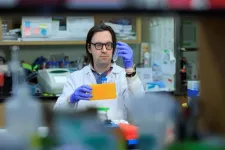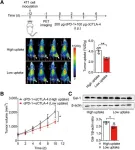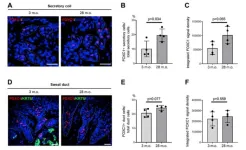(Press-News.org) A Monash-led study - the first to globally map heatwave-related mortality over a three-decade period from 1990 to 2019 – has found that an additional 153,000+ deaths per warm season were associated with heatwaves, with nearly half of those deaths in Asia.
In comparison to 1850–1990, the global surface temperature has increased by 1.14℃ in 2013–2022 and is expected to increase by another 0.41-3.41℃ by 2081–2100. With the increasing impacts of climate change, heatwaves are increasing not only in frequency but also in severity and magnitude.
The study, published today in PLOS Medicine and led by Monash University’s Professor Yuming Guo, looked at data on daily deaths and temperature from 750 locations in 43 countries or regions.
The study – done in collaboration with Shandong University in China, London School of Hygiene & Tropical Medicine in UK, and universities/research institutes from other countries- found that, during 1990–2019, heatwaves led to an increase in deaths of 236 deaths per ten million residents per warm season of a year. The regions with the highest heatwave-related deaths were in:
Southern and Eastern Europe
in areas had polar and alpine climates
where residents had high incomes
Locations with tropical climate or low incomes were observed with the greatest decline in heatwave-related mortality burden from 1990 to 2019.
According to Professor Guo, studies so far looking at increased deaths related to exposure to heatwaves has been studied, “the evidence mainly comes from limited locations,” he said.
“Our findings that heatwaves are associated with substantial mortality burden that varies spatiotemporally over the globe in the past 30 years suggest that there should be localised adaptation planning and risk management across all government levels.”
According to the study’s authors heatwaves cause an increased risk of death due to overwhelming thermal stress on human body and triggering dysfunction of multiple organs as well as heat exhaustion, heat cramps, and heatstroke. The heat stress can also aggravate pre-existing chronic conditions, leading to premature death, psychiatric disorders and other outcomes.
END
150,000+ people died in three decades to 2019 due to heatwaves according to first global mapping of heat-triggered mortality
First study to globally map heatwave-related mortality finds 153,000+ deaths associated with heatwaves
2024-05-14
ELSE PRESS RELEASES FROM THIS DATE:
Study tallies heatwave deaths over recent decades
2024-05-14
Between 1990 and 2019, more than 150,000 deaths around the globe were associated with heatwaves each year, according to a new study published May 14th in PLOS Medicine by Yuming Guo of Monash University, Australia, and colleagues.
Heatwaves, periods of extremely high ambient temperature that last for a few days, can impose overwhelming thermal stress on the human body. Studies have previously quantified the effect of individual heatwaves on excess deaths in local areas, but have not compared these statistics around the globe over such ...
Early diagnosis & treatment of peripheral artery disease essential to improve outcomes, reduce amputation risk
2024-05-14
Guideline Highlights:
The new joint guideline from the American Heart Association and the American College of Cardiology provides recommendations to guide clinicians in the treatment of patients with lower extremity peripheral artery disease (PAD) and supports broad implementation of the PAD National Action Plan – an outline of six strategic goals to improve awareness, detection and treatment of PAD nationwide.
The guideline urges clinicians to be aware of the signs and symptoms of PAD in its four clinical presentations (asymptomatic, chronic symptomatic PAD, chronic limb-threatening ...
Innovative USask 'mini-brains' could revolutionize Alzheimer’s treatment
2024-05-14
SASKATOON--Using an innovative new method, a University of Saskatchewan (USask) researcher is building tiny pseudo-organs from stem cells to help diagnose and treat Alzheimer’s.
When Dr. Tyler Wenzel (PhD) first came up with the idea of building a miniature brain from stem cells, he never could have predicted how well his creations would work.
Now, Wenzel’s “mini-brain” could revolutionize the way Alzheimer’s and other brain-related diseases are diagnosed and treated.
“Never in our wildest dreams did we think that our crazy idea would work,” ...
$1 million grant project tackles economic, marketing gaps in US aquaculture
2024-05-14
MEDIA INQUIRES
Laura Muntean
laura.muntean@ag.tamu.edu
601-248-1891
FOR ...
MIT researchers discover the universe’s oldest stars in our own galactic backyard
2024-05-14
MIT researchers, including several undergraduate students, have discovered three of the oldest stars in the universe, and they happen to live in our own galactic neighborhood.
The team spotted the stars in the Milky Way’s “halo” — the cloud of stars that envelopes the entire main galactic disk. Based on the team’s analysis, the three stars formed between 12 and 13 billion years ago, the time when the very first galaxies were taking shape.
The researchers have coined the stars ...
How to ensure biodiversity data are FAIR, linked, open and future-proof? Policy makers and research funders receive expert recommendations from the BiCIKL project
2024-05-14
Within the Biodiversity Community Integrated Knowledge Library (BiCIKL) project, 14 European institutions from ten countries, spent the last three years elaborating on services and high-tech digital tools, in order to improve the findability, accessibility, interoperability and reusability (FAIR-ness) of various types of data about the world’s biodiversity. These types of data include peer-reviewed scientific literature, occurrence records, natural history collections, DNA data and more.
By ensuring all those data are readily available and efficiently interlinked to each other, the project consortium’s intention is to provide better tools to the scientific community, ...
Lessons in chemistry: Guo aims at fundamental understanding of emerging semiconductor material
2024-05-14
Metal halide perovskites have emerged in recent years as a low-cost, highly efficient semiconducting material for solar energy, solid-state lighting and more. Despite their growing use, a fundamental understanding of the origins of their outstanding properties is still lacking. A Husker scientist is aiming to find answers that could lead to the development of new materials and new applications.
Yinsheng Guo, assistant professor of chemistry at the University of Nebraska–Lincoln, also wants to transform how physical chemistry is taught to undergraduate and graduate students, who often struggle to understand and apply what ...
Newly identified PET biomarker predicts success of immune checkpoint blockade therapy
2024-05-14
Reston, VA—The protein galectin-1 (Gal-1) has been identified as a new PET imaging biomarker for immune checkpoint blockade (ICB) therapy, allowing physicians to predict the tumor responses before beginning treatment. Information garnered from Gal-1 PET imaging could also be used to facilitate patient stratification and optimize immunotherapy, enabling targeted interventions and improving patient outcomes. This research was published in the May issue of The Journal of Nuclear Medicine.
Immunotherapies, such as ICB, have produced promising clinical ...
Age-associated gene expression changes in mouse sweat glands
2024-05-14
“In this study, we first obtained evidence that, in mouse, aging primarily reduced the number of active sweat glands.”
BUFFALO, NY- May 14, 2024 – A new research paper was published in Aging (listed by MEDLINE/PubMed as "Aging (Albany NY)" and "Aging-US" by Web of Science) Volume 16, Issue 8, entitled, “Characterization of age-associated gene expression changes in mouse sweat glands.”
Evaporation of sweat on the skin surface is the major mechanism for dissipating heat in humans. The secretory capacity of sweat glands (SWGs) ...
26-year-old heart transplant and stroke survivor named national champion for women’s health
2024-05-14
DALLAS, May 13, 2024 — Fewer than half of all women are aware that heart disease is their leading cause of death. That is why the American Heart Association, celebrating one hundred years of lifesaving service, created its community-based Woman of Impact™ initiative as an outgrowth of its year-round Go Red for Women® activist movement. The movement spotlights the lack of awareness and the clinical care gaps in women’s heart health. This year’s National Winner of the Go Red for Women 2024 Woman of Impart initiative is a 26-year-old heart transplant recipient, stroke survivor and American Heart Association local volunteer, Hana Hooper from Puget ...
LAST 30 PRESS RELEASES:
Numbers in our sights affect how we perceive space
SIMJ announces global collaborative book project in commemoration of its 75th anniversary
Air pollution exposure and birth weight
Obstructive sleep apnea risk and mental health conditions among older adults
How talking slows eye movements behind the wheel
The Ceramic Society of Japan’s Oxoate Ceramics Research Association launches new international book project
Heart-brain connection: international study reveals the role of the vagus nerve in keeping the heart young
Researchers identify Rb1 as a predictive biomarker for a new therapeutic strategy in some breast cancers
Survey reveals ethical gaps slowing AI adoption in pediatric surgery
Stimulant ADHD medications work differently than thought
AI overestimates how smart people are, according to HSE economists
HSE researchers create genome-wide map of quadruplexes
Scientists boost cell "powerhouses" to burn more calories
Automatic label checking: The missing step in making reliable medical AI
Low daily alcohol intake linked to 50% heightened mouth cancer risk in India
American Meteorological Society announces Rick Spinrad as 2026 President-Elect
Biomass-based carbon capture spotlighted in newly released global climate webinar recording
Illuminating invisible nano pollutants: advanced bioimaging tracks the full journey of emerging nanoscale contaminants in living systems
How does age affect recovery from spinal cord injury?
Novel AI tool offers prognosis for patients with head and neck cancer
Fathers’ microplastic exposure tied to their children’s metabolic problems
Research validates laboratory model for studying high-grade serous ovarian cancer
SIR 2026 delivers transformative breakthroughs in minimally invasive medicine to improve patient care
Stem Cell Reports most downloaded papers of 2025 highlight the breadth and impact of stem cell research
Oxford-led study estimates NHS spends around 3% of its primary and secondary care budget on the health impacts of heat and cold in England
A researcher’s long quest leads to a smart composite breakthrough
Urban wild bees act as “microbial sensors” of city health.
New study finds where you live affects recovery after a hip fracture
Forecasting the impact of fully automated vehicle adoption on US road traffic injuries
Alcohol-related hospitalizations from 2016 to 2022
[Press-News.org] 150,000+ people died in three decades to 2019 due to heatwaves according to first global mapping of heat-triggered mortalityFirst study to globally map heatwave-related mortality finds 153,000+ deaths associated with heatwaves








